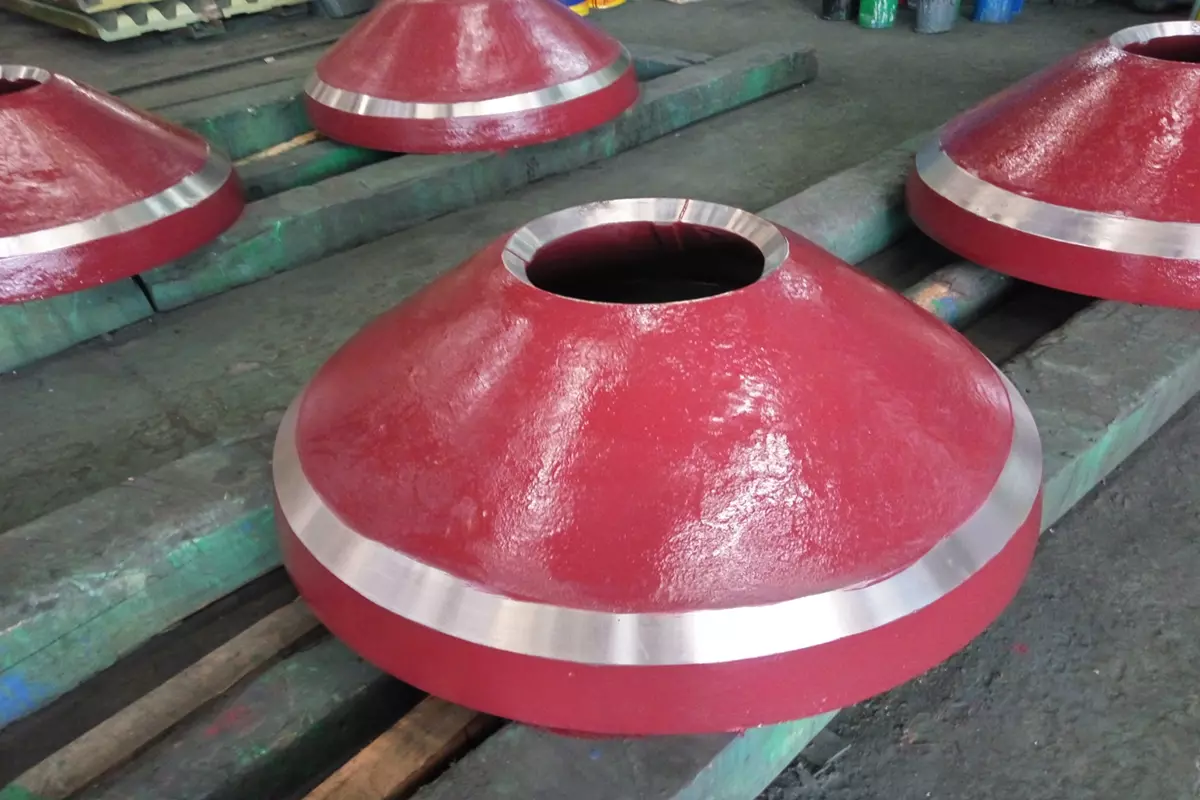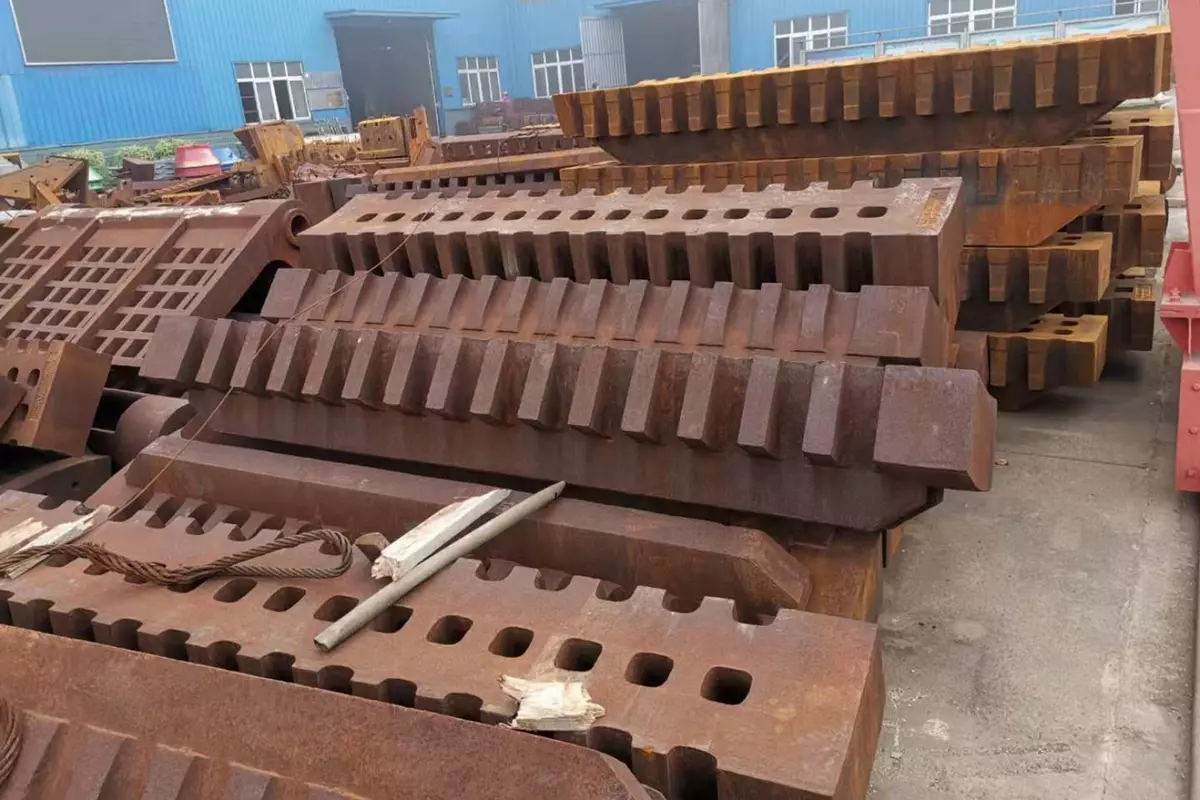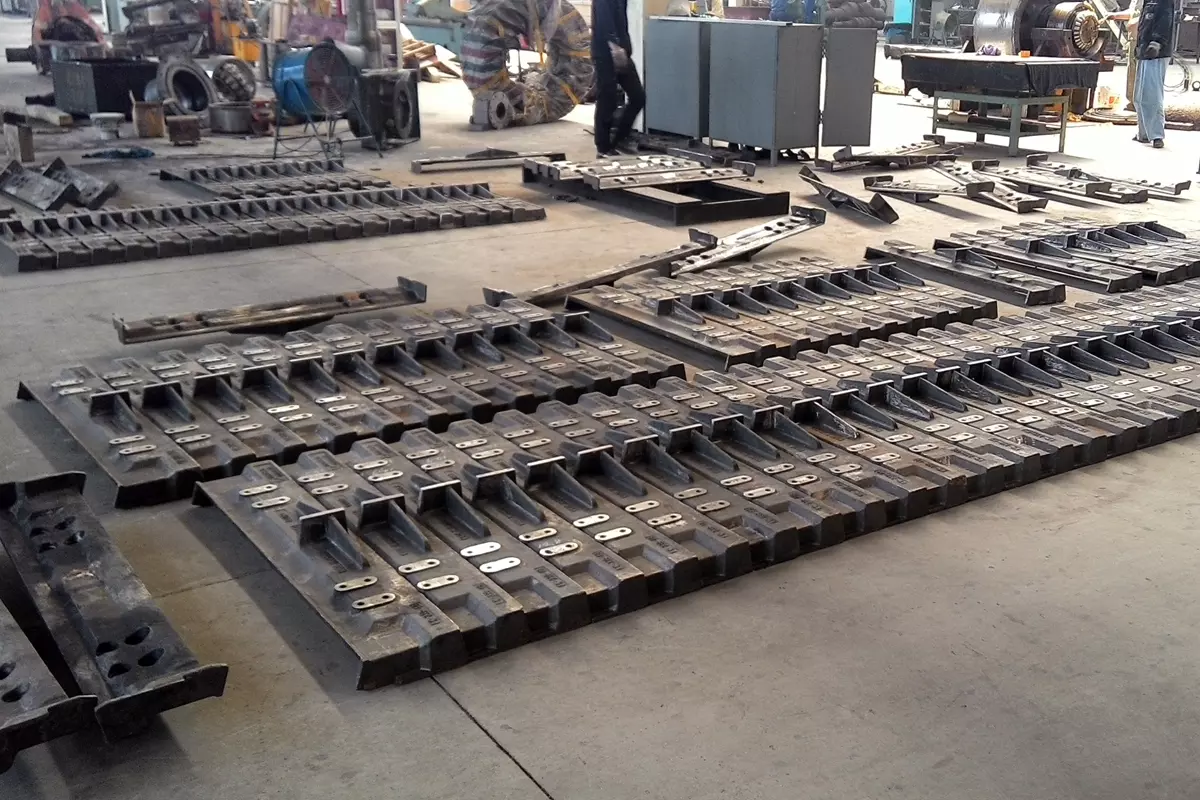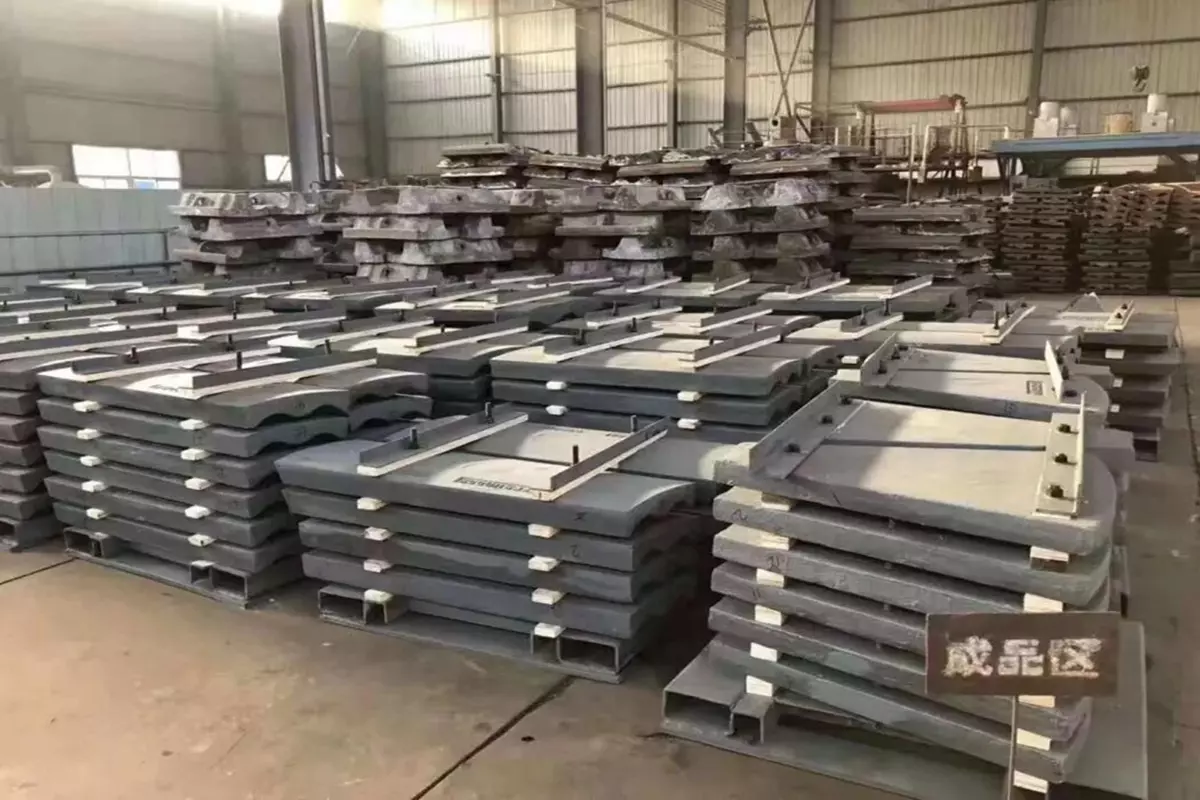Nanjing Manganese Manufacturing Co; Ltd (MGS Casting), which is the expert in manganese steel casting area. The manganese steel is “ASTM A128 Austenitic Manganese Steel”. High Mn, solid solution (non-magnetic), work hardening steel. it’s terribly high strength, ductility, toughness and wonderful wear resistance within the most grueling applications. additionally, this steel features terribly low constant of friction that is incredibly vital to wear resistance – particularly in steel to steel applications. This steel thrives on severe wear conditions. A lot of impact and pounding it receives, the more durable the surface of the steel becomes. This characteristic is thought work-hardening. the very fact that the fabric remains ductile beneath, makes it a handiest steel in combating impact and abrasion. This steel is weldable with special high Mn electrodes. thanks to this steel’s work hardening characteristics, it doesn’t lend itself to machining by standard strategies.
Manganese Steel Casting Foundry
Manganese Steel Casting Parts
Know More+
Manganese Steel Casting Parts Heat Treatment
Ideally, heat treated manganese steels can have a totally homogenized fine-grained solid solution microstructure. The grain size may be a perform of gushing temperature and warmth treatment generally doesn’t influence the grain size. Some have tried to develop ways of warmth treatment that will 1st rework the structure to a pearlitic structure, which might then give grain refinement within the final heat treatment. These ways haven’t been widely accepted or enforced for numerous reasons. One reason is that these cycles become pricey because of the high chamber temperatures and long hold times needed. additionally, the alloy was usually not considerably improved by these cycles.
The typical heat treatment cycle for many atomic number 25 sheets of steel consists of an answer normalize followed by a water quench. This cycle could take off at the temperature or at associate elevated temperature reckoning on the beginning temperature of the castings. The beginning temperature within the heat treat chamber is ready to be close to the castings temperature and is then raised at a slow to moderate rate till the soaking temperature is reached. Soaking temperatures are generally high so as to facilitate the dissolution of any inorganic compound which may be gift. Temperatures at or close to 2000°F ar generally wont to deliver the goods the specified homogenizing result. The chemical composition of the alloy can ultimately set the soaking temperature.
Manganese steel castings need a fast water quench following the warm temperature soak. This quench must occur instantly when the castings are faraway from the warmth treatment chamber. the speed of this quench must be high enough to forestall any precipitation of carbides. Figure eight shows the microstructure of properly quenched austenitic manganese steel. A slack quench will cut back the toughness of the fabric dramatically. within the toughened condition austenitic manganese steel castings are often final processed with very little special care.
The one item to avoid with heat-treated austenitic manganese steel castings is reheating higher than 500°F. Temperatures at or higher than this level can cause the precipitation of needle-shaped carbides, which might dramatically cut back the toughness. This result is time and temperature based mostly with longer times and better temperatures each inflicting larger losses of toughness.
Manganese Steel Casting Machining
Manganese steel’s unique wear resistant properties also make it very difficult to machine, at best. In the early days of manganese steel production, it was thought to be unmachineable and grinding was used to shape the parts. Now with modern cutting tools it is possible to turn, bore and mill manganese steels. Manganese steel does not machine like other steels and typically requires tools that are made with a negative rake angle. In addition, relatively low surface speeds with large depths of cut produce the best results. This arrangement produces high cutting forces and the equipment and tooling must be robust to withstand these forces. Any chatter of the tooling can add to the work hardening of the surface being machined. Most cutting is typically done without any sort of lubrication. During the machining of manganese it is important to continuously remove the work-hardened zone with the next cut. Small finishing cuts or tool chatter will cause the hardness to build and make the remaining surface virtually unmachineable.
Drilling of manganese steels, while possible, is very difficult and required holes should be cast into the part versus drilled. If drilled holes are required, mild steel inserts are often cast into the part so that the machineable insert can be drilled or drilled and tapped.
Standard Composition Ranges for Austenitic Manganese Steel Castings ( ASTM A128 )
| Grade | C% | Mn% | Cr% | Mo% | Ni% | Si(max)% | P(Max)% |
| A……. | 1.05-1.35 | 11.0 min | — | — | — | 1.00 | 0.07 |
| B-1 | 0.9-1.05 | 11.5-14.0 | — | — | — | 1.00 | 0.07 |
| B-2 | 1.05-1.2 | 11.5-14.0 | — | — | — | 1.00 | 0.07 |
| B-3 | 1.12-1.28 | 11.5-14.0 | — | — | — | 1.00 | 0.07 |
| B-4 | 1.2-1.35 | 11.5-14.0 | — | — | — | 1.00 | 0.07 |
| C……. | 1.05-1.35 | 11.5-14.0 | 1.5-2.5 | — | — | 1.00 | 0.07 |
| D……. | 0.7-1.3 | 11.5-14.0 | — | — | 3.0-4.0 | 1.00 | 0.07 |
| E-1…. | 0.7-1.3 | 11.5-14.0 | — | 0.9-1.2 | — | 1.00 | 0.07 |
| E-2…. | 1.05-1.45 | 11.5-14.0 | — | 1.2-2.1 | — | 1.00 | 0.07 |
| F……. | 1.05-1.35 | 6.0-8.0 | — | 0-9-1.2 | — | 1.00 | 0.07 |
Mechanical Properties of Austenitic Manganese Steel Casting
| IS Grade | Tensile Strength Min (MPa) | Yield Stress Min (Mpa) | Elongation Percent Min | Hardness HB Max | Angle of Bend Degrees Min |
| 1 | 600 | 300 | 24 | 229 | 150 |
| 2 | — | — | — | 229 | 150 |
| 3 | 600 | 300 | 24 | 229 | 150 |
| 4 | — | — | — | 229 | 150 |
| 5 | — | — | — | 229 | 150 |
| 6 | — | — | — | 280 | 150 |
| 7 | — | — | — | 280 | 150 |
Effects of Various Elements In Manganese Steel Casting
Different elements have different functions and effects in the manganese steel casting wear parts.
Carbon Element. Carbon is one of the two most important elements in manganese steels along with manganese. Manganese steels are a supersaturated solution of carbon. For most standard manganese steel grades the carbon and manganese are in an approximate ratio of Mn/C=10. These steels, therefore, are typically 12% Mn and 1.2% C. This ratio was mainly set up by early steel-making limitations and the fixed ratio has no real significance. Increasing the carbon content raises the yield strength and lowers the ductility. See the following picture for the effects of increasing carbon content on the properties of 13% manganese steel.
Most manganese steels are used in gouging abrasion and high impact wear situations so manufacturers try to maximize carbon contents. Practical limits do exist and as the carbon content exceeds 1.3% cracking and undissolved grain boundary carbides become more prevalent. The premium grades of manganese steels, those with high manganese contents, have pushed the upper carbon limit well beyond 1.3%.
Manganese Element. Manganese is an austenite stabilizer and makes this family of alloys possible. It decreases the austenite to ferrite transformation temperature and therefore helps to retain a fully austenitic structure at room temperature. Alloys with 13% Mn and 1.1% C have martensite start temperatures below -328°F. The lower limit for manganese content in plain austenitic manganese steel is near 10%. Increasing manganese levels tend to increase the solubility of nitrogen and hydrogen in the steel. Premium alloys with higher carbon contents and additional alloy elements exist with manganese levels from 16-25% manganese. These alloys are proprietary to their manufacturer.
Silicone Element. The specification content of silicon in high manganese steel is 0.3% ~ 0.8%. Silicon will reduce the solubility of carbon in austenite, promote carbide precipitation, and reduce the wear resistance and impact toughness of steel. Therefore, the silicon content should be controlled at the lower specification limit.
Phosphorus Element. The specification content of high manganese steel is P ≤ 0.7%. When smelting high manganese steel, because of the high phosphorus content in ferromanganese, the phosphorus content in steel is generally high. Because phosphorus will reduce the impact toughness of steel and make the casting easy to crack, the phosphorus content of steel should be reduced as much as possible.
Sulphur Element. The specification of high manganese steel requires S ≤ 0.05%. Due to the high manganese content, most of the sulfur and manganese in the steel combine with each other to form manganese sulfide (MNS) and enter the slag. Therefore, the sulfur content in the steel is often low (generally no more than 0.03%). Therefore, the harmful effect of sulfur in high manganese steel is higher than that of phosphorus.
Chromium Element. Chromium is used to increase the tensile strength and flow resistance of manganese steels. Additions of up to 3.0% are often used. Chromium increases the solution-annealed hardness and decreases the toughness of the manganese steel. Chromium does not increase the maximum work-hardened hardness level or the strain hardening rate. Chromium bearing grades require higher heat treatment temperatures as chromium carbides are more difficult to dissolve into solution. In some applications, chromium can be beneficial, but in many applications, there is no benefit to adding chromium to manganese steel.
Molybdenum Element. Molybdenum additions to manganese steels result in several changes. First, the martensite starts temperature is lowered which further stabilizes the austenite and retards carbide precipitation. Next, molybdenum additions change the morphology of the carbides that form during reheating after the material has had a solution treatment. Grain boundary films of acicular carbides typically form, but after adding molybdenum the carbides that precipitate are coalesced and dispersed through the grains. The result of these changes is that the toughness of the steel is improved by the addition of molybdenum. Another benefit of molybdenum additions can be improved as-cast mechanical properties. This can be a real benefit during casting production. In higher carbon grades molybdenum will increase the tendency for incipient fusion, so care must be taken to avoid this as the resulting mechanical properties will be severely diminished.
Nickel Element. Nickel is a strong austenite stabilizer. Nickel can prevent transformations and carbide precipitation even at reduced cooling rates during quenching. This can make a nickel a useful addition in products that have heavy section sizes. Increasing nickel content is associated with increased toughness, a slight drop in tensile strength and has no effect on the yield strength. Nickel is also used in welding filler materials for manganese steels to allow the as-deposited material to be free from carbides. It is typical to have lower carbon levels in these materials along with the elevated nickel to produce the desired result.
Aluminum Element. Aluminum is used to deoxidize manganese steel, which can prevent pinhole and other gas defects. It is typical to use additions of 3lbs/ton in the ladle. Increasing aluminum contents decreases the mechanical properties of manganese steel while increasing brittleness and hot tearing. In practice, it is advisable to keep aluminum residuals fairly low for most grades of manganese steel.
Titanium Element. Titanium can be used to deoxidize the manganese steel. In addition, titanium can tie up nitrogen gas in titanium nitrides. These nitrides are stable compounds at steelmaking temperatures. Once tied up the nitrogen is no longer available to cause pin holing in the castings. Titanium can also be used to refine the grain size, but the effect is minimal in heavier sections.
Comparison of Manganese Steel Casting With Different Working Conditions
For the condition of weak impact abrasive wear:
high manganese steel can not work hardening basically. Because of the small impact force and a low requirement on material toughness, materials with high original hardness can be selected, such as air transportation and hydraulic transmission pipeline, which can be made of basalt cast stone. For the second and third bins of cement mill, the grinding medium is small and the impact force is small, so the brittle wear-resistant materials such as low chromium cast iron, high chromium cast iron, and even white cast iron can be selected. The service life of manganese steel can be increased by 1-4 times.
For low impact abrasive wear conditions:
Although high manganese steel can produce work hardening, its hardness is very low. Due to the low impact force, high carbon high manganese steel, medium manganese steel, bainitic steel, low alloy martensite steel, and bainite ductile iron can be selected. For example, for the lining plate (No.1 bin) of the large mill, the service life of the alloy martensitic steel zg42crmnsi2mo can be increased by 2-3 times without deformation. Especially now, the grinding medium in cement grinding gradually popularizes the use of high chromium cast ball, which does not match the hardness of high manganese steel lining plate well, which accelerates the deformation of lining plate and reduces the service life, which shows the necessity of replacing high manganese steel. When crushing the material with Proctor hardness f ≤ 12, the service life of 400 × 600 jaw crusher plate made of medium alloy martensitic steel can be increased by 20% ~ 50%, and the iron scraps in the crushed material can be sucked out to improve the purity of the material, which is beneficial to increase the whiteness of white cement and reduce the small iron oxide cave of silica brick. In addition, the small crusher hammer can be made of steel with a certain toughness of 12kg.
For medium impact abrasive wear conditions:
For example, when the impact energy is 4J, it is equivalent to crushing the ore with F = 12-14. Martensitic steel and modified high manganese steel with better toughness can be selected for gear plate, and their wear resistance is increased by 20% – 100% compared with high manganese steel. We also use high manganese steel and high chromium cast steel bonded composite tooth plate to crush granite. The service life of manganese steel is increased by 2.5 times.
For strong impact abrasive wear conditions:
when the impact energy is greater than 5J and the ore hardness is f = 16-19, the safety or wear resistance of martensitic steel as tooth plate or liner plate is not enough, and high manganese steel series material is still needed. For example, the wear resistance of φ 200 cone crusher is about 50% higher than that of standard high manganese steel by using chromium and titanium modified high manganese steel to crush f = 17-19 ores. When crushing f = 12-14 ores, the wear resistance increases by 70% – 100%, which means that the wear resistance gap between the two is narrowed in the case of strong impact wear. It is possible that under the condition of a strong impact, their work hardening rates are similar. The original hardness of the modified high manganese steel is higher, and the surface hardness of the modified high manganese steel remains high, reaching about hv700, while that of the standard high manganese steel is more than hv600 after hardening, but the hardness difference is smaller than that under the moderate impact, resulting in the wear resistance difference also reduced. Ultra-high manganese steel can be used to ensure the normal operation of some large size hammers under the strong impact. When the hardness of ore f ≤ 14, the service life of low alloy martensitic steel is about 50% higher than that of standard high manganese steel. For ore with hardness f > 14, the standard high manganese steel is still used in China. The production and use of modified high manganese steel are affected due to its high raw material cost, complex production process, and strict requirements. In foreign countries, martensitic steel is the first choice of lining material, and then rubber liner is widely used. Its service life can be increased by 1-5 times compared with the standard high manganese steel, and the power consumption, ball consumption, mill noise, and labor intensity during maintenance are also reduced. China’s rubber products industry is developing this product.




